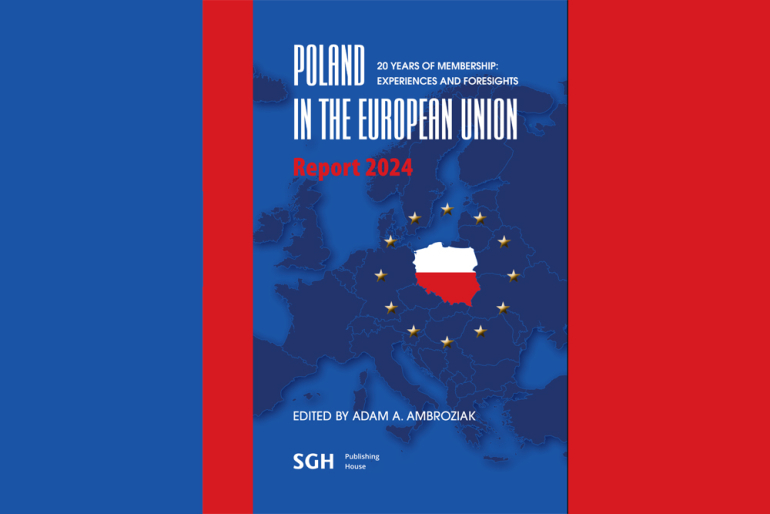Poland in the European Union. 20 Years of Membership: Experiences and Forecasts. Report 2024

Thirty years ago, the European Agreement establishing an association between the European Communities and their Member States and Poland came into force. Twenty years ago, Poland, along with most of the Central and Eastern European countries, joined the European Union. These two anniversaries have provoked the researchers from the Department of European Integration and Legal Studies (WWW.SGH.WAW.PL/KIIPE) of SGH Warsaw School of Economics to prepare a monography “Poland in the European Union. Report 2024. 20 Years of Membership: Experiences and Forecasts” (HTTPS://WWW.SGH.WAW.PL/KGS/PUBLIKACJE-PRACOWNIKOW-KATEDRY-INTEGRACJI-I-PRAWA-EUROPEJSKIEGO). This is the fifth annual report of the Department on the evolution of relations between Poland and other EU Member States. In these reports we have discussed the issues we believe to be the most relevant to Poland’s integration within the European Union. Each year we concentrate on the most interesting issues , touching on both the economic and legal aspects.
In the first chapter of this year’s report, titled “Changes in Poland’s foreign trade after accession to the European Union”, Elżbieta Kawecka-
-Wyrzykowska finds that Poland’s foreign trade growth has been impressive during the surveyed period, both with respect to other EU partners and non-EU countries. In the 21st century, Poland has been one of the countries with the fastest growing exports to other EU countries, in relative terms, which has strengthened its position among EU suppliers – reaching a 6% share in intra-EU exports and imports in 2022. Just before the accession, EU suppliers covered slightly more than 65% of Poland’s import needs. In the last two years, this figure barely exceeded 50%, which largely reflected the differences in the scale of price increases for basic products imported from the EU and outside. EU partners’ position in Poland’s exports has been much stronger: around 70 % over the whole period. Exports to both EU partners and to third countries are dominated by industrial products – around 80% in recent years. Agricultural products amount to around 15% of exports in both geographical directions.
In the chapter titled “The evolving role of the European Union in Polish trade in services and major developments of the intra-EU services trade of Poland” Dariusz Mongiało reveals that Poland was a net exporter to the EU market of services. He also shows that Germany stands as the key destination of Polish services and their top supplier to Poland (occupying the same first position as in Poland’s trade in goods). Most important Polish export services delivered to the EU Internal Market are currently: transport, other business services, and ICT. These two-way flows confirm a high degree of similarity between the Polish economy and the economies of other EU countries as regards road transport, computer services and in travel. This two-ways trade in services suggests also that Polish service companies operating in these sectors could take advantage of the benefits from intra-industry specialization as well.
In the next chapter, titled “Poland and the EU economic and monetary union,” Artur Nowak-Far shows that in the pre-accession period, participation in the full EMU was seen both by the EU institutions and the Polish government(s) as a clear consequence of EU membership. Nevertheless, the agenda related to Poland’s transition to full EMU membership was undermined by the apparent lack of robustness of the EMU construct during the 2008+ global financial crisis and in 2015 by an obvious political shift in public sentiment towards a more Eurosceptic political stance. The most important tactical ramification is that during major economic stress (i. e. the 2008+ global economic crisis and the COVID-19 crisis) Poland retained much broader room for manoeuvre in economic policy than it might have had in the euro zone. Moreover, over the recent years, Poland has experienced a high degree of real convergence with the euro zone.
In chapter four, titled “Poland’s environmental policy after accession to the European Union,” Marzenna Błaszczuk-Zawiła proves that as an EU Member State, Poland met many of its environmental commitments on time. Some of them (transposition of certain directives) were implemented behind schedule, while on some issues it is still difficult to predict the timeline for compliance. Between May 2004 and December 2022, the Commission opened 120 infringement proceedings against Poland in relation to environmental legislation (especially in waste management, air and water quality, and nature conservation). Many of the environmental issues faced by Poland remain a major challenge for most or a large group of EU Member States, due to reasons such as the high level of environmental protection prescribed by EU law.
The next chapter, titled “From emigration to immigration – how EU membership changed migration-related challenges in Poland”, by Michał Schwabe, reveals that although the first years of Poland’s EU membership only confirmed Poles’ willingness to emigrate to the West for work, since the second decade of the 21st century, the character of Poland as a country of emigration has begun to gradually change. Emigration of unskilled labour to the West created a growing demand for labour, especially for seasonal workers in the agricultural sector. This demand was met primarily by increasing immigration from the former USSR countries (mainly from Ukraine). A positive migration balance was recorded in Poland for the first time in 2016, and just one year later, i.e. in 2017, Poland was the country with the largest number of temporary foreign workers in the world according to OECD data. The crisis on the Polish-Belarusian border triggered by the Belarusian regime in 2021, as well as the unprecedented influx of forced migrants from Ukraine, who had to flee their homeland due to an unprovoked Russian invasion in 2022 are reflected in the analysis.
The sixth chapter, titled “State aid in Poland after accession to the EU. Twenty years of financial interventions in the market economy” by Adam A. Ambroziak, says that throughout the period of 2004–2021, Poland was among the largest state aid providers and was gradually lifting its position. The nominal and relative value of aid provided in Poland was the highest in the first years after the start of successive EU multiannual budgets, indicating a considerable dependence of public interventions in Poland on EU funds. This trend was not accompanied by an equally rapid convergence in the structure of the support provided: this was especially true for R&D&I aid, but despite this, aid for environmental protection and energy efficiency was either far from sufficient or did not provide for allocations that followed European trends.
Chapter seven, by Tomasz Grzybowski, looks at “Europeanization of Polish judicial system (perspective of administrative judiciary).” The presence of Poland in the EU and signing the Convention for the Protection of Human Rights and Fundamental Freedoms, and consequently the influence of European law on the Polish legal systems, appear to be something self-evident, both in terms of law-making and especially law application. Regarding application of the law, there is, however, a widespread belief that an interpretive perspective based on the objectives of EU law, especially in harmonized areas, is something natural at the current stage of development of both national and EU legal systems. Therefore, legal cultures, and particularly their axiological foundations, were harmonised not only at the level of the legal text, but also through legal discourse, expressed particularly in the dialogue of national and international court jurisdictions.
In summary, successive reports prepared by the team of researchers from the Department of European Integration and Legal Studies at SGH had shown that Poland’s accession to the European Union has made it possible to achieve various goals. They facilitated the country’s further economic and social development, such as significant expansion of the market for Polish goods, stabilization of the economic law system, impressive inflow of foreign capital needed to modernize the economy and create new jobs (in the form of direct investments as well as some European funds), etc. At the same time, new development challenges (including climate change, pressure from foreign migrants to access wealthier European countries, ensuring security of supply of critical raw materials, including energy, etc.) make it clear that the optimal path for economically and politically secure development of Poland is to deepen and broaden European integration and strengthen Poland’s position in the EU. These are areas of interest and study by the staff of the Department of European Integration and Legal Studies.

DR HAB. ADAM A. AMBROZIAK, prof. SGH, Head
of the Department of European Integration and Legal Studies,
SGH Collegium of World Economy



